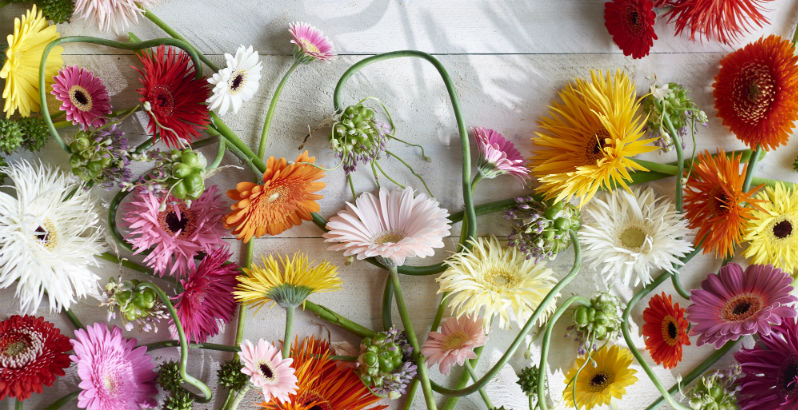
New Standards in Gerberas
The gerbera cut flower business is full of challenges and opportunities. While production and labor costs continue to increase, growers have to create their own unique mix of smart variety selection, cultivation decisions, the right market segment to target and catchy marketing concepts. Cost-efficient production, selecting varieties that fit your specific market segment and creative ideas to stand out from the crowd have become critical.
Choosing the Right Varieties for Your Market
By closely looking into the variety characteristics while composing your assortment, you can definitely get ahead of the game. Obviously, growers will make the ultimate decision based on the market segment they want to target. But no matter how you come to that decision, it is most important to distinguish yourself in the market with guaranteed quality.
As a breeder, Florist Holland trials its varieties intensively in various climates around the world and collects valuable data to share with customers. A large number of pre- and post- harvest trials take place before even making a variety commercially available. Longevity testing is done internally, but also externally by an independent ISO-certified research facility. All products are tested for vase life and other quality characteristics, such as flower bud opening or the presence of Botrytis. Flowers are put through a sales simulation test: from grower to auction and from buyer/retailer/florist to the consumer. Varieties that do not pass these tests will not end up in our catalog.
At Florist Holland, each variety has its own unique “Flower Passport” with objective information used for our own selection. It is a starting point for improvement by our R&D team and the basis for a new standard in gerberas. We can advise growers in detail and on variety level about flower production per square meter, flower features, effect of fertilizers and irrigation, hardiness/resistance and crop maturation. Intensive post-harvest trialing gives insight in vase life; effect of pre-treatments; ethylene and Botrytis sensitivity; influence of temperature fluctuations; and transport in water, sleeves or boxes.
A Benchmark for New Varieties
Production levels greater than 300 stems per square meter and a two-week vase life have become the benchmark for breeding. Proven performers in standard gerbera include varieties such as Prestige (orange), Panama (yellow), Blinddate (red), Rihanna (hot pink) and Cubanita (purple/white bicolor).
With the latest gerbera collection for 2018, some great new varieties will enter the market. The top five new and high-yielding standard gerberas are: Evi, Atlanta, Lemonade, Hamptons and Jetset.
For growers looking for everything that they have grown to love, but just a little smaller, consider Bieber (white/pink bicolour), NEW Caramba (orange), Boost (purple), Okidoki (yellow) and Binq (red).
To get the best results and to be cost efficient, smart cultivation decisions are key. It is important to to change crops. While growers traditionally used their plants up to five years, a quicker crop change would result in less crop maintenance and a higher yield. Old crops require more spraying and labor costs and result in lower flower production. A three-year crop change is ideal and will pay for itself.
Enriching Your Assortment
Growers want to distinguish their business from the rest, and retailers are looking for exciting new items to wow the crowds. By adding specialties to the assortment, a grower can become a one-stop show and get in a position where price is not the only factor anymore.
To differentiate your gerbera offering, you can turn to special colors or two tones. When we dive a little deeper into the world of gerberas, however, you can discover a whole range of exclusive gerbera flower shapes to broaden the scope.
Picollini proves that special things come in small packages. The world’s tiniest gerbera is exceptionally petite, cute and colorful. On top of that, Piccolini has a huge production level (30 percent higher compared to mini gerberas), outstanding vase life and an excellent price point in an expanding market.
Pomponi gerberas are mini, rounded, fully double gerberas with an immense amount of flower petals. They definitely add an interesting, exclusive twist.
Lighten up your assortment with an extravagant mix of FireworX. These festive flowers have spiky looking petals and are available in a colorful range of standard and mini size varieties.
Products with a Story
“Tell me a fact and I’ll learn. Tell me the truth and I’ll believe. But tell me a story and it will live in my heart forever.” This famous proverb explains it well: Storytelling is a must nowadays to truly connect with your market.
For Piccolini, we recently developed a new concept with a clear story where our customers can add value. This promotes sales on a huge level and, from a practical point of view, it also helps efficient processing.
Piccolini is all about emotion and comes in a special heart-shaped gift packaging, to celebrate the little things in life. These little gift moments can truly be found throughout the year: not only a “Happy Valentine’s Day” or “Happy Mother’s Day” but also tiny gestures as little as a “Happy Weekend,” “Happy New Job,” “Happy Summer,” or “Happy First Day of School.” Piccolini in a nutshell: “Enjoy the little things.”
Retailers and florists love it:
- The world’s tiniest gerbera
- Wide color scheme
- Easy to use as mono and mix
- Excellent vase life
- Exclusive packaging
Consumers love it:
- Super tiny = super cute
- Brings cheerfulness and color
- Tiny flowers, grand gesture
- Sweet gift item
- Easy for DIY home decorations
So … what story would you like to tell?





 Video Library
Video Library 




















